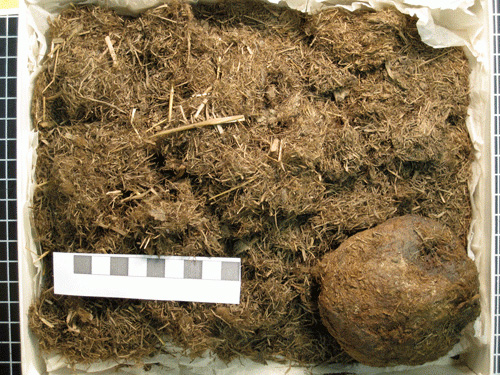
One fall day in Interior Alaska, a lion stalked a ground squirrel that stood exposed on a hillside like a foot-long sandwich. The squirrel saw bending blades of grass, squeaked an alarm call, and then dived into its hole. It curled up in a grassy nest. A few months later, for reasons unknown, its heart stopped during hibernation.
Twenty thousand years later, Ben Gaglioti is teasing apart the mummified ground squirrel’s cache in an attempt to better reconstruct what Alaska was like during the days of the mammoth, bison, wild horse and camel.
Gaglioti is a graduate student with the University of Alaska Fairbanks Institute of Arctic Biology and the Water and Environmental Research Center. He is using tools ranging from tweezers to an isotope-analyzing device in his attempt to sift Alaska’s distant past from the midden of a ground squirrel that perished during the last ice age. At that time, from about 14,000 to 45,000 years ago, North America looked much different than it does today.
For one thing, blue ice one mile thick was pressing down on Toronto and Chicago. Massive sheets covered much of the continent, but northern Alaska was a grassland, part of what UAF scientist Dale Guthrie called the “Mammoth Steppe.”
The Mammoth Steppe blanketed the top of the globe from about France to Whitehorse. It was cold, dry, and featured grasses and sedges. So rich were the feeding grounds that the ancestors of today’s animals were jumbo versions.
“Sheep, bison, caribou, and other ruminants on the Mammoth Steppe were giants,” Guthrie wrote in “Frozen Fauna of the Mammoth Steppe.”

Not many ground squirrels live in Interior Alaska today, probably because the current landscape of tundra and boreal forest plants doesn’t provide them enough nutrition. But the squirrels were here during the ice age. A few of them perished within their dens, and, through a rare process of being buried and then frozen, became mummified.
While blasting hillsides of frozen soil with water to reach the gold-bearing gravel below, miners of Interior Alaska often found remains of ice age mammals, including a mummified bison that Guthrie extracted. Miners sometimes told scientists of their discoveries, prompting researchers such as UAF’s Otto Geist to recover the bones of mammoths and other remains of ancient animals.
Geist and other scientists recovered more than a dozen ancient ground squirrel nests from Alaska and Yukon Territory. They sent many of the nests and caches — and sometimes the mummified squirrels — to the American Museum of Natural History in New York City. Other researchers dated the remains and found the squirrels had lived from roughly 40,000 to 8,000 years ago.
Gaglioti, the UAF graduate student, is picking the seeds and leaves from the ancient squirrel middens and identifying what plants were here during the last ice age. He’s finding plants that are still in Alaska as well as grasses that grow today on the Great Plains of the United States and Canada.
“Some interesting northern prairie species are showing up,” he said.
To compare the diets of Mammoth Steppe squirrels to living ground squirrels, Gaglioti also traveled to the North Slope and dug up several ground squirrel caches, finding that those squirrels seem to prefer certain berries and willow leaves. His goal is to reconstruct Alaska’s ice age groundcover.
“We’re trying to understand the nature of the Mammoth Steppe — the habitats here before the extinction of the large mammals and the arrival of humans into North America,” he said. “As things are changing — like if it’s getting dryer and warmer in modern-day Alaska — we might be able to draw on these details from the past to better understand climate and vegetation relationships in Alaska.”
“Snow’s all around the classrooms of kids in Alaska, Canada and much of the U.S.,” Sturm said. “I’d like to think teachers wherever there is snow would find the book useful, and help them use snow right outside their classrooms to make their teaching better and more interesting.”
Ned Rozell for UAFGI
The Alaska Science Forum has been provided as a public service by the Geophysical Institute, University of Alaska Fairbanks, in cooperation with the UAF research community. Ned Rozell is a writer at the institute. Posted by Ned Rozell on March 04 2010 http://www.gi.alaska.edu/alaska-science-forum/mummy-ground-squirrel-tells-different-alaska
Frontier Scientists: presenting scientific discovery in the Arctic and beyond